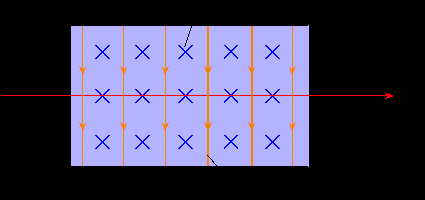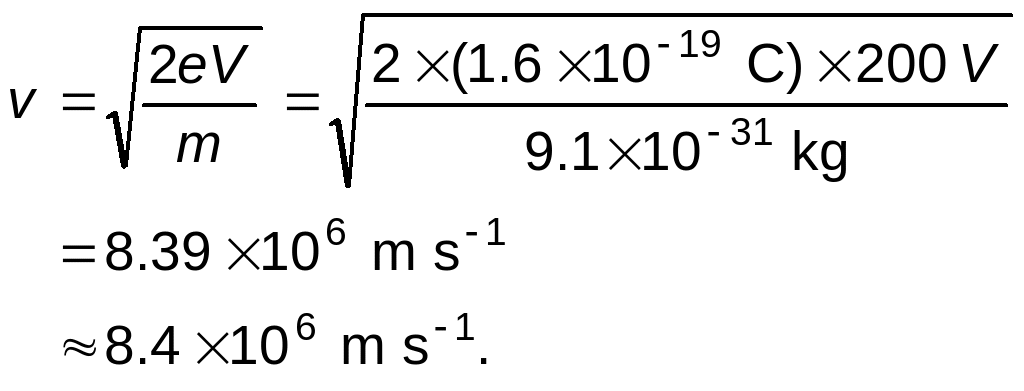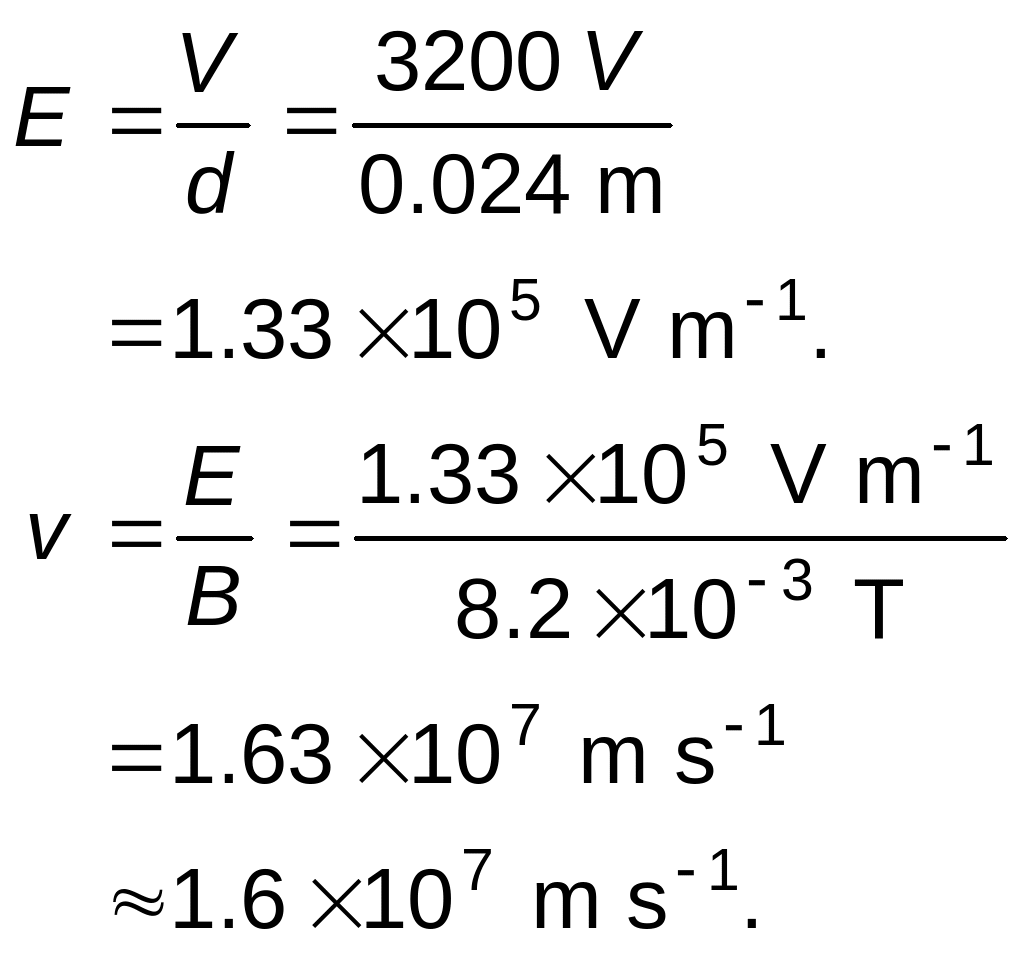TAP 518 7 FIELDS IN NATURE AND IN PARTICLE
07%20Playing%20fields12 I WAS DYING OF HUNGER NEAR FIELDS OF
13982-essendon-fields-referral-form
162 CITY ROAD LONDON EC1V 2PD EMAIL MASMOORFIELDSNHSUK “PROMOTING
2002 FRESHFIELDS LECTURE 19 ARB INT’L 279 (2003) ARBITRATION’S
27 CURRICULUM VITAE ALAN DOWTY PRINCIPAL FIELDS OF INTEREST
TAP 518- 7: Fields in nature and in particle accelerators
TAP 518- 7: Fields in nature and in particle accelerators
Instructions and information
Write your answers in the spaces provided. The following data will be needed when answering these questions:
electronic charge = – 1.6 10–19 C
mass of electron = 9.1 10–31 kg
0 = 8.9 10–12 F m–1
Questions
Suppose that a thundercloud has a flat horizontal base of area 1 km2. The base of the cloud is 200 m above the Earth’s surface so that a uniform electric field is formed between the cloud and the Earth. A field of 106 V m–1 between the base of the cloud and the Earth is sufficient to cause a lightning flash.
1. Calculate the potential difference between the cloud and the ground at the moment the lightning flash begins.
2. The charge on the base of the cloud is given by the formula Q = 0 A E where A is the area of the base of the cloud and E is the electric field strength between the base and the Earth. Calculate the charge on the base of the cloud.
3. The cloud and the Earth can be thought of as a parallel plate capacitor that stores energy when charged. Assuming that the potential difference immediately after the flash is very small compared with the potential difference at the beginning of the flash, calculate a value for the energy released during the flash.
Electrons accelerated through a potential difference of 200 V enter a uniform magnetic field of 0.001 T perpendicular to the direction of motion.
4. Calculate the speed of the electrons when they enter the magnetic field.
5. Use your answer to question 4 to calculate the radius of the orbit in the magnetic field.
In an electron tube, electrons were passed through a region containing a vertical electric field E and a horizontal magnetic field B. When the forces on the electron were balanced the electrons passed through the tube undeflected.

6. Show that the electrons of charge e pass undeflected when they have a velocity v = E/B.
The separation of the deflector plates was 24 mm and no deflection was observed when the voltage across the plates was 3.2 kV and the magnetic field was 8.2 10–3 T.
7. Calculate the velocity of the electrons.
The voltage used to accelerate the electrons to this velocity was 750 V.
8. Use your answer to question 7 to calculate the ratio e/m for electrons where m is the mass of an electron.
A proton joined to a neutron is known as a deuteron or deuterium ion and is used in nuclear scattering experiments. A deuteron has a mass of 3.3 10–27 kg and a charge of
+ 1.6 10–19 C.
9. Calculate the voltage required to accelerate a deuteron from rest in a vacuum to a velocity of 9 106 m s–1 (3% of the speed of light).
In an early form of particle accelerator, deuterons were made to move in a circular path within a toroidal tube of diameter 1 m. A toroidal tube is like a hollow ring.
10. Calculate the magnetic field required to constrain a deuteron within the tube at the velocity of 9 106 m s–1.
Hints
4. The charge and mass of the electron are given in the ‘Instructions and information’.
6. The electric and magnetic forces are equal in magnitude.
7. You will need to change the units before calculating the electric field strength.
8. You will need to consider the equation for the electron gun used to accelerate the electrons.
9. You are used to calculating the speed of electrons when accelerated. The mass of a deuteron is not the same as the mass of an electron.
10. The question gives the diameter of the orbit and not the radius.
Practical advice
In questions 7 and 8 there are several stages in the calculation so excessive rounding in the earlier parts of the question would lead to errors in the final answer. All answers have been rounded to two significant figures, but three significant figures have been used for numerical values that have been carried through to the next stage of the calculation.
Answers and worked solutions

2.

3.
![]()
4.
![]()
so

5.
![]()
so

6.
![]()
so
![]()
7.

8.
![]()
so

9.
![]()
so

10.
![]()
so

External reference
This activity is taken from Advancing Physics chapter 16, 160S
5-mary_stagecoach_mary_fields
6 EVENT LISTINGS SUBMISSION FORM & GUIDELINES MANDATORY FIELDS
853_863Fields
Tags: fields in, fields, particle, nature
- THE CONSTITUTION OF THE JOHN GLENN COLLEGE OF PUBLIC
- 36 RUNNING HEAD ORGANIZATIONAL COMMITMENT CHAPTER 6 ORGANIZATIONAL COMMITMENT
- ARYTMETYKA LICZB SYSTEMEM LICZENIA NAZYWAMY SPOSÓB TWORZENIA LICZB ZE
- CRPDCPERQPR23 NACIONES UNIDAS CRPDCPERQPR23 CONVENCIÓN SOBRE LOS DERECHOS DE
- BUDAPEST FŐVÁROS XI KERÜLETI ÖNKORMÁNYZAT 592004XII20 XIÖK SZÁMÚ RENDELETE
- Gottesdienst Ordnung Katholische Kirchengemeinde st Maria Esslingenberkheim in
- MILTON KEYNES L C A FIELD SURVEY RECORD SHEET
- AJÁNLATTÉTELI DOKUMENTÁCIÓ A SOPRONI ERZSÉBET OKTATÓ KÓRHÁZ ÉS REHABILITÁCIÓS
- WESTERN MICHIGAN UNIVERSITY [TYPE DEPARTMENT NAME HERE] PRINCIPAL
- APPLICATION FOR MEMBERSHIP OF SOCIETY THE SOCIETY OF NOTARIES
- PROYECTOS Y RECURSOS EXPERIENCIA ARTÍSTICA TUTORA ASCENSIÓN MORENO
- WWWCROAZIAINFOIT CROAZIAINFOIT DI BRANKO E NICOLETTA CAPITANERIA DI PORTO
- VIIDIRTEPOLPNPLIMA COMITÉ ESPECIAL BASES ADJUDICACIÓN DE MENOR CUANTIA Nº
- HANDBOOK FOR LOCAL PASTORS AND ASSOCIATE MEMBERS NORTH CAROLINA
- PREVENTION OF LAUNDERING PROCEEDS OF CRIME LAW LAW NO
- UZ MEĐUNARODNI DAN ŽENA U GOSPIĆU KONCERT SEVDAHA LICKENOVINELICKENOVINEHR
- WYNIKI KONKURENCJI SPORTOWYCH PŁYWANIE KOBIET SZTAFETA 4X50 MIEJSCE MIASTO
- PART 621—SOILS AND CULTURAL RESOURCES TABLE OF CONTENTS PART
- EKONOMIKA GOSPODARKI ŻYWNOŚCIOWEJ (EKONOMIA II) ELASTYCZNOŚĆ POPYTU I PODAŻY
- “second International Convention on Ethics in Research on Human
- WWFIUCN GLOBAL REVIEW OF FOREST FIRES GLOBAL REVIEW OF
- DEPARTAMENTO DE POLÍTICAS MIGRATORIAS Y JUSTICIA MIGRAZIO POLITIKETAKO ETA
- NYILATKOZAT ALULÍROTT [XX] POSTACÍM EMAIL CÍM TELEFONSZÁM HOZZÁJÁRULOK AZ
- IN THE GRIEVING AFTER THE FIRES YOU WILL NEED
- IDENTIFICATION DESCRIPTION ABSTRACT WESTERN GRAINS TRANSITION PAYMENT PROGRAM (WGTPP)
- REKAYASA KUALITAS TAGUCHI DALAM PERANCANGAN PARAMETER KUALITAS PRODUK MOEHAMAD
- UNIVERSITY HOSPITALS BRISTOL NHS FOUNDATION TRUST TREASURY MANAGEMENT POLICY
- OPAKOVANIE SLOVIES MENO TRIEDA ŠK ROK 1
- WZÓR METAPLANU PROBLEM CHOROBY UKŁADU KRĄŻENIA JAK BYĆ POWINNO?
- AMPARO DIRECTO EN REVISIÓN 20272005 AMPARO DIRECTO EN REVISIÓN
 COMUNICADO DE PRENSA JUNIO DE 2016 RENAULT PRESENTA ALASKAN
COMUNICADO DE PRENSA JUNIO DE 2016 RENAULT PRESENTA ALASKAN RESUMEN DREAMWORKS EMPRENDIMIENTO IDEA 1 ALINEAR COMPARTIR RECURSOS
RESUMEN DREAMWORKS EMPRENDIMIENTO IDEA 1 ALINEAR COMPARTIR RECURSOSIES LA ASUNCIÓN DE ELCHE PROBLEMAS DE CINEMÁTICA DE
MATILDE GARCÍA VERASTEGUI DIRECTORA ADJUNTA PARA TEMAS GLOBALES SECRETARIA
 CURRICULUM VITAE ABREVIADO (OCTUBRE 2015) CRISTINA GARCÍAVIVAR CENTRO DE
CURRICULUM VITAE ABREVIADO (OCTUBRE 2015) CRISTINA GARCÍAVIVAR CENTRO DEMESA 1 DESENVOLVEMENTO ECONÓMICO E EMPREGO PROGRAMA 1 APOIO
3 EPIDURAL AND NERVE BLOCK PATIENT INFORMATION SHEET DEPARTMENT
XXXIII EDICION JUEGOS DEPORTIVOS DEL PRINCIPADO DE ASTURIAS 20182019
RECHTSWISSENSCHAFT IM NATIONALSOZIALISMUS BIBLIOGRAPHIE (BIBLIOGRAPHIE LEXIKON DEUTSCHSPRACHIGE RECHTSLEHRER
9 ПОЯСНИТЕЛЬНАЯ ЗАПИСКА К ПРОЕКТУ РЕШЕНИЯ «О ВНЕСЕНИИ ИЗМЕНЕНИЙ
TRANSFERENCIA AL EXTERIOR MODELO DE PODER FUERA DE REGISTRO
 STRAIGHT CONNECTOR 49 STRAIGHT CONNECTOR 48 STRAIGHT CONNECTOR 45
STRAIGHT CONNECTOR 49 STRAIGHT CONNECTOR 48 STRAIGHT CONNECTOR 45 P MBASADOR RIJAVNICA ZA REZERVACIJU SMJEŠTAJA APPLICATION FORM FOR
P MBASADOR RIJAVNICA ZA REZERVACIJU SMJEŠTAJA APPLICATION FORM FORTERCERA PARTE DEL PROYECTO VAMOS A UTILIZAR PARA EL
FORM 67 GRANT OF A RIGHT OF WAY BY
ZAŁĄCZNIK NR 3 DO JN1441P100000 ZNAK WNIOSKU (WYPEŁNIA JEDNOSTKA
STATE OF MINNESOTA DEPARTMENT OF COMMERCE WEIGHTS & MEASURES
 LAMBERTSETER HELHETSMEDISIN FOR BEDRE HELSE OG LIVSKVALITET! HOMEOPATI
LAMBERTSETER HELHETSMEDISIN FOR BEDRE HELSE OG LIVSKVALITET! HOMEOPATI HOMEWORK SHEET 1 – NUMBER 1 THESE WERE SOME
HOMEWORK SHEET 1 – NUMBER 1 THESE WERE SOMEROLF JOSEPH CRAVEN 2429 WOODFIELD CIRCLE LEXINGTON KENTUCKY 40515